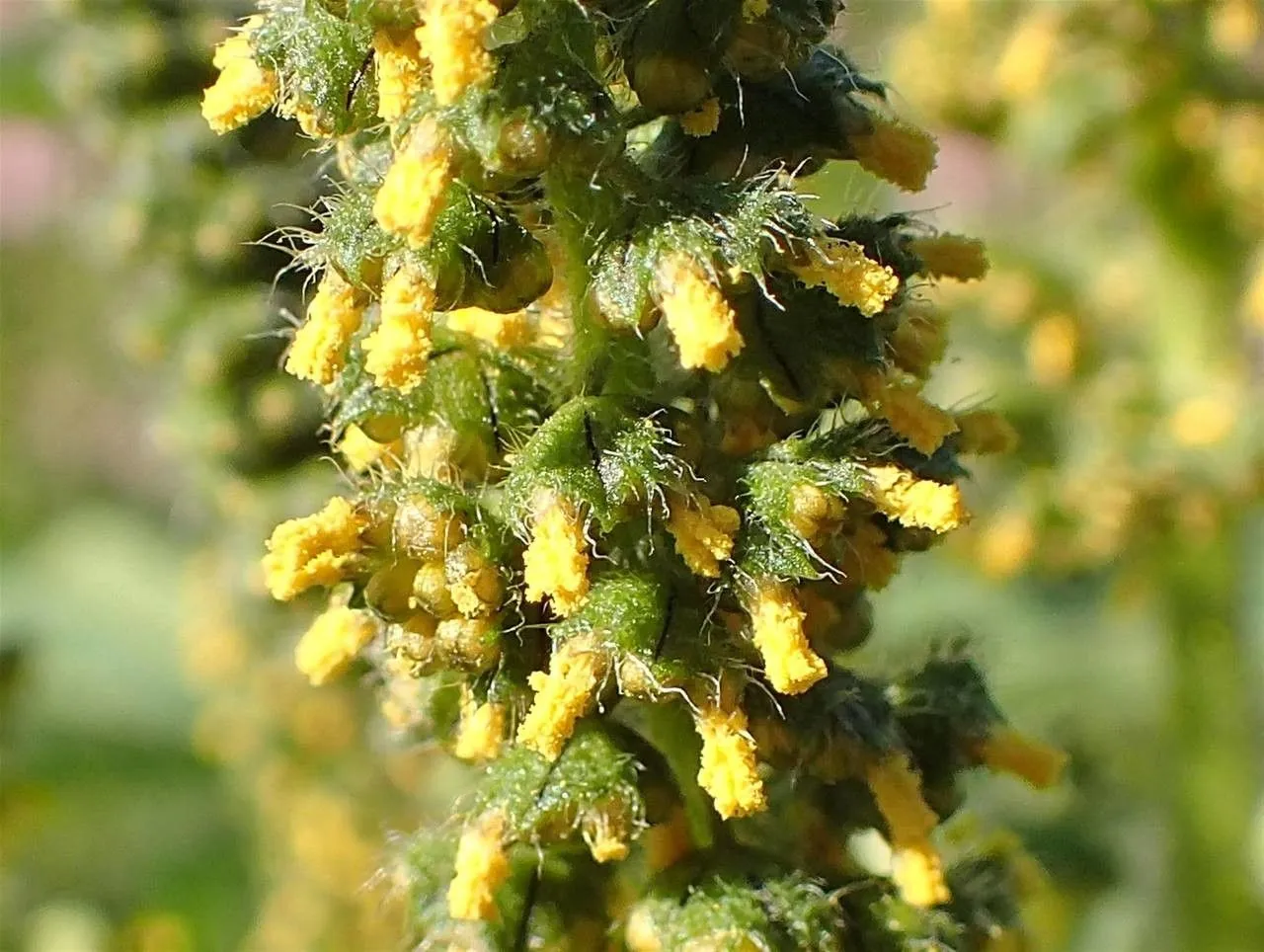
Author: L.
Bibliography: Sp. Pl.: 987 (1753)
Year: 1753
Status: accepted
Rank: species
Genus: Ambrosia
Vegetable: False
Observations: N. America
Horseweed, scientifically known as Ambrosia trifida, is a notable plant hailing from North America. This species, designated in Carl Linnaeus’ Species Plantarum (Sp. Pl.) published in 1753, belongs to the Asteraceae family, which is renowned for its diverse array of flowering plants.
Ambrosia trifida is a resilient and adaptable plant, often identified by its characteristic tall and robust structure. It thrives in various habitats and is primarily found across the North American continent, where it contributes to the region’s rich botanical diversity.
Typically, horseweed exhibits greenish stems and jagged leaves which can vary in shape and size. The plant is known for its vigorous growth and ability to spread, making it a common sight in prairies, meadows, and disturbed lands such as roadsides and fields. Due to its adaptability, it often becomes a subject of interest for botanists and ecologists studying plant behavior and ecosystem dynamics.
Despite its modest appearance, Ambrosia trifida holds a significant place in its native ecosystems, providing essential contributions to the flora community. Whether viewed as a fascinating species for botanical study or a resilient inhabitant of the North American landscape, horseweed stands as a testament to the intricate web of natural plant life supported by the Asteraceae family.
Fra: ambroisie trifide, grande herbe à poux, ambrosie trifide
Heb: ambrosia seshu’a
Ita: ambrosia trifida
Swe: backnejlika, borstnejlika, brödranejlika, skorem, hästambrosia, sormituoksukki, ambrosia
Dan: bakke-nellike, skorem, studenter-nellike, trefliget ambrosie
Eng: blood ragweed, buffalo-weed, giant ragweed, great ragweed, horseweed, perennial ragweed, tall ragweed, texan great ragweed
Nor: busknellik, engnellik, kartusarnellik, skorem
Deu: dreilappige ambrosie, dreilappiges traubenkraut, dreispaltiges traubenkraut
Fin: harjaneilikka, ketoneilikka, munkkineilikka, varsanpolvi, sormituoksukki
Lit: triskiautė ambrozija
Ces: ambrozie trojklaná
Nno: hesteambrosia
Nob: hesteambrosia
Est: kolmehõlmane ambroosia
Lav: trīsdaivu ambrozija
Nld: driedelige ambrosia
Cym: bratlys enfawr, bratlys mawr
En: Horseweed, Giant ragweed, Buffalo-weed, Great ragweed, Texan great ragweed, Blood ragweed, Perennial ragweed, Tall ragweed
Zh: San lie ye tun cao
Cs: Ambrozie trojklaná
Da: Bakke-Nellike, Skorem, Studenter-Nellike, Trefliget ambrosie
Nl: Driedelige ambrosia, Drielobbige Ambrosia
Et: Kolmehõlmane ambroosia
Fi: Harjaneilikka, Ketoneilikka, Munkkineilikka, Varsanpolvi, Sormituoksukki
Fr: Grande herbe à poux, Ambroisie trifide, Ambrosie trifide
De: Dreilappiges Traubenkraut, Dreilappige Ambrosie, Dreispaltiges Traubenkraut
He: Ambrosia seshu’a, אמברוסיה שסועה
It: Ambrosia trifida, Ambrosia perenne
Lv: Trīsdaivu ambrozija
Lt: Triskiautė ambrozija
No: Busknellik, Engnellik, Kartusarnellik, Skorem
Nb: Hesteambrosia
Nn: Hesteambrosia
Es: Altamisa gigante
Sv: Hästambrosia, Backnejlika, Borstnejlika, Brödranejlika, Skorem, Sormituoksukki, Ambrosia
Cy: Bratlys Enfawr, Bratlys Mawr
Taken Aug 26, 2015 by EOL − botany08 (cc-by)
Taken Oct 16, 2022 by Julia Flowerpot (cc-by-sa)
Taken Sep 14, 2021 by Marilyn Cummins (cc-by-sa)
Taken Aug 15, 2021 by Eric (cc-by-sa)
Taken Oct 13, 2022 by William Coville (cc-by-sa)
Taken Aug 9, 2020 by Fern (cc-by-sa)
Taken Mar 12, 2022 by Daniel Ruiz (cc-by-sa)
Taken Sep 16, 2021 by Patrick M (cc-by-sa)
Taken Aug 14, 2021 by Reya Andrews (cc-by-sa)
Taken May 18, 2021 by Mike Spadafore (cc-by-sa)
Taken Sep 19, 2021 by Jochen Schäfer (cc-by-sa)
Taken Aug 27, 2021 by Rena Woode (cc-by-sa)
Taken Aug 27, 2021 by Rena Woode (cc-by-sa)
Taken Mar 6, 2015 by EOL − Richard Spellenberg (cc-by-nc-sa)
Taken Feb 5, 2015 by EOL − Richard Spellenberg (cc-by-nc-sa)
Taken Jun 18, 2017 by Yoan MARTIN (cc-by-sa)
Taken Jun 18, 2017 by Yoan MARTIN (cc-by-sa)
Taken Jun 18, 2017 by Yoan MARTIN (cc-by-sa)
Taken Jun 18, 2017 by Yoan MARTIN (cc-by-sa)
Taken May 31, 2014 by EOL − Linda Jo Conn (cc-by-nc)
Taken Aug 15, 2007 by Photoflora – Jean-Luc TASSET (©)
Taken Apr 6, 2020 by Kendra RaiderNature (cc-by-sa)
Taken Aug 17, 2020 by pot linaya (cc-by-sa)
Taken Aug 17, 2009 by EOL − Ron Thomas (cc-by-nc-sa)
Taken Aug 20, 2009 by EOL − Ron Thomas (cc-by-nc-sa)
Taken Jul 12, 2021 by Brad Kelley (cc-by-sa)
Taken Jul 15, 2022 by Perrine DHÉNIN (cc-by-sa)
Taken Jun 3, 2020 by Aaron Harp (cc-by-sa)
© copyright of the Board of Trustees of the Royal Botanic Gardens, Kew.
© copyright of the Board of Trustees of the Royal Botanic Gardens, Kew.
© copyright of the Board of Trustees of the Royal Botanic Gardens, Kew.
Growth habit: Subshrub, Forb/herb
Ph maximum: 8.0
Ph minimum: 7.5
Light: 9
Atmospheric humidity: 4
Soil nutriments: 6
Family: Myrtaceae Author: (F.Muell.) K.D.Hill & L.A.S.Johnson Bibliography: Telopea 6: 402 (1995) Year: 1995 Status:…
Family: Rubiaceae Author: Pierre ex A.Froehner Bibliography: Notizbl. Bot. Gart. Berlin-Dahlem 1: 237 (1897) Year:…
Family: Sapindaceae Author: Koidz. Bibliography: J. Coll. Sci. Imp. Univ. Tokyo 32(1): 38 (1911) Year:…
Family: Asteraceae Author: A.Gray Bibliography: Pacif. Railr. Rep.: 107 (1857) Year: 1857 Status: accepted Rank:…
Family: Fabaceae Author: Medik. Bibliography: Vorles. Churpfälz. Phys.-Ökon. Ges. 2: 398 (1787) Year: 1787 Status:…
Family: Aspleniaceae Author: (Cav.) Alston Bibliography: Bull. Misc. Inform. Kew 1932: 309 (1932) Year: 1932…